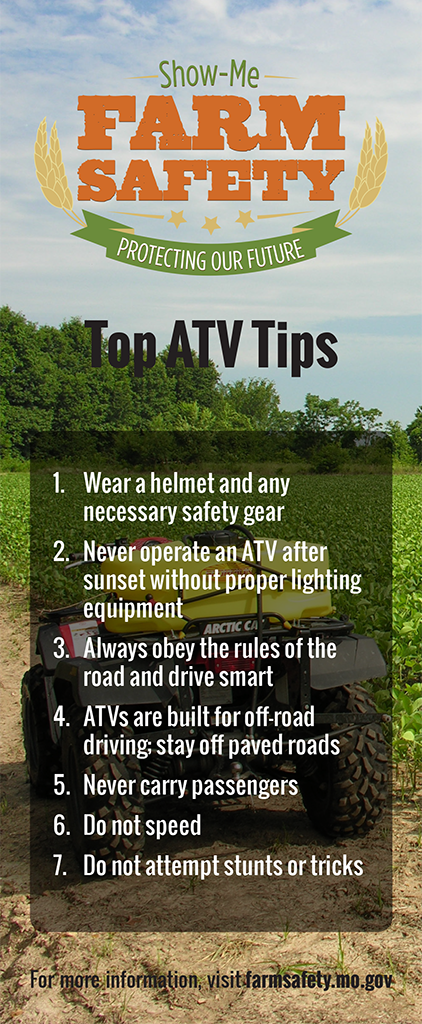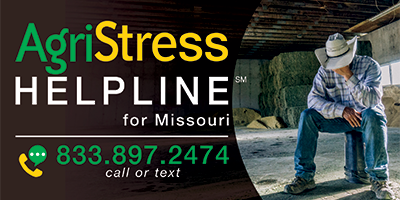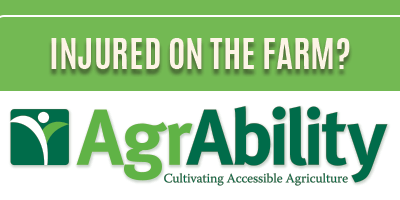All-Terrain Vehicles
All-terrain vehicle (ATV) use continues to increase as the agriculture sector realizes the ease ATVs provide. Even though ATVs lighten up the workload, the amount of associated fatalities and injuries is increasing at an alarming rate. Following safety requirements and practicing caution are essential to prevent ATV-related accidents.
The absence of a cab or any protective barrier increases the risk of ejection from an ATV. A helmet is the single most important piece of protective equipment when riding an ATV. There are many different options when it comes to selecting a helmet for riding ATVs. You should only select a helmet that has the label of the Department of Transportation, the American National Standards Institutes or the Snell Memorial Foundation. Full-face helmets offer the most protection, guarding the face and the head. Open-faced helmets are lighter to wear, but should always be worn with a chin guard to protect the chin and mouth. Both types of helmets should fit snugly and be securely fastened when riding the ATV. Eye protection is very important when riding ATVs. Getting hit with an object like a branch, rock, or bug while driving can cause injury and possible blindness. Wearing a helmet with a face shield or riding goggles will protect your eyes while riding ATVs. If you choose to wear goggles, be sure they are well-ventilated, securely fastened and free from scratches to prevent distraction. Driving ATVs for extended periods of time can make your hands sore and tired. Gloves offer protection and comfort while driving and can prevent injuries in case of an accident. Wear appropriate clothing when riding, including a long-sleeved shirt and long pants, to prevent cuts and scrapes on the body. Exposed skin can be severely damaged by branches or rocks. It is important to wear shoes that prevent your feet from slipping off the footrests when riding an ATV. Boots that lace up and are at least above the ankle are encouraged for support.
Each state has a set of laws pertaining to the legal age and conditions of operating ATVs. Safety Comes First: A Reference Guide for ROHV/UTC/Motorized Bicycle Missouri law also says that children under 16 can legally operate an ATV, but if they are not on land owned by their parent or guardian, they must ride under adult supervision. Never allow small children to operate ATVs by themselves; they may be big enough to reach the throttle and brakes, but may lack the ability to know how to use those controls to operate the ATV. It is illegal to operate ATVs on Missouri highways, except for agricultural purposes but only between sunrise and sunset. If you ride your ATV on the highway, you should wear all necessary safety gear and carry a valid driver’s license. The majority of ATV accidents involve young riders, alcohol, passengers or using ATVs on public roads. To ensure the safety of those riding the ATV, do not allow passengers to ride the ATV, unless for agricultural purposes. And, as with any motor vehicle, never drink alcohol when operating an ATV. Impairments will result in potentially more severe injuries.
An ATV should be checked frequently to ensure peak operational function. Inspecting the ATV before each use will minimize the risk of injury.
These parts should be checked before operating your ATV:
- Tires: Always maintain the recommended tire pressure in each tire. Use a low pressure gauge to check the pressure. Most automobile tire gauges do not accurately measure low pressure in ATV tires. Use a torque wrench to tighten and secure all wheel lug nuts, and rock the tire to check for worn-out bearings and loose nuts.
- Throttle: Off-road riding in dirt and mud can cake cables, limit movement and keep the throttle from closing. Check the throttle operation while moving the handlebars fully to the left and right.
- Brakes: Brakes can prevent an ATV accident in a matter of seconds. They are one of the most important parts on an ATV and should be kept in prime condition. If an adjustment needs to be made, consult the owner’s manual before adjusting to prevent injury.
- Lights: When riding at night or on roads, lights are needed to alert others that you are on an ATV. Make sure all lights are properly connected and all bulbs are working before riding.
- Fuel and oil: Before riding, check to make sure you have enough oil and fuel to last for the duration of your trip and check that you do not have fuel or oil leaks.
- Drive-train and chassis: Riding on rough terrain will loosen chassis parts. Check each part to ensure all are tightly secured, including handlebars, and footrests, and adjust with fasteners with a wrench if necessary.



